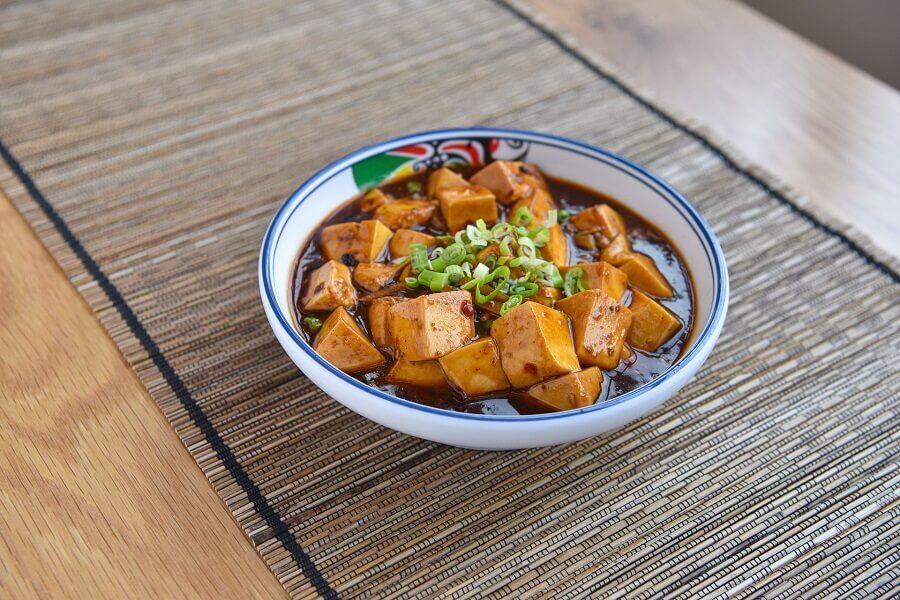A Guide To Tofu
Health and Wellbeing
Your cart is empty.
SUBTOTAL
£0.00

Health and Wellbeing
Here’s everything you need to know about this plant-protein ingredient and how to cook with it.
Tofu is a food made from soya milk which is curdled and pressed into solid white blocks—similar to how cheese is made by curdling and solidifying milk. Soy milk is mixed with a coagulant, usually nigari. This is the solution you get when you extract salt from sea water. It’s full of minerals, and is used to help solidify tofu and maintain its shape. They’re simmered until the curds and the whey separate, then placed into molds and pressed until the whey is drained.
Tofu varies in firmness, and it all depends on how it’s processed. The longer it’s pressed, the firmer the tofu will be. When shopping for tofu, you’ll find that it comes in different degrees of firmness: silken, soft, firm and extra firm. They all have different textures and culinary properties, so which kind of tofu you use will depend on the recipe you’re making.
Tofu originated in China some 2,000 years ago, and legend has it that a Chinese cook discovered it by accident when he mixed soy milk with nigari. It was introduced to Japan in the eighth century, and didn’t arrive in the Western world until the 1960s when the appeal of healthy eating started to rise. Today, it’s a budget-friendly way of including plant-based protein into your diet.

Tofu is an excellent source of protein, making it a popular choice for vegetarians and vegans. It also contains all nine essential amino acids and is a good plant source of the minerals iron, calcium, manganese, phosphorus, magnesium, copper, zinc and vitamin B1.
A 100g serving contains:
73 kcal
4.2g fat
0.5g sat fat
0.7g carbohydrate
8.1g protein
Tofu is thought to provide the same health benefits as soya beans. Soya protein can help reduce the risk of heart disease and lower levels of bad cholesterol. It also reduces inflammation of the blood vessels and improves their elasticity.
Consuming tofu has also been shown to reduce the risk of certain cancers including breast cancer, prostate cancer and stomach cancer. This protective effect comes from isoflavones, a class of plant-derived flavonoids which have antioxidant, anticancer, antimicrobial and anti-inflammatory effects.

Although tofu is quite flavourless on its own, this is what makes it such a versatile ingredient to cook with. It can be cooked in many different ways, whether that’s grilled, deep fried, stir fried, steamed, baked or even added to a smoothie.
Before you start cooking, it’s best to press the excess water out of the tofu by patting it with a tea towel or kitchen roll. This gives it a firmer, less slimy bite. When cooking tofu, you don’t need to let it sit for too long as it very quickly absorbs whatever sauce, marinade or spices you’re using.
Add chopped tofu to curries and stews, fried rice, vegetable or noodle stir-fries, and pan roasted vegetables. You can pan-fry it with sesame and garlic sauce, add it to lasagna, or even coat it with breadcrumbs and deep fry it as a snack to serve with a dipping sauce. When it’s barbecue weather, marinate tofu with your favourite marinade and grill (we love this fiery Jamaican marinade).
Silken tofu is very delicate and requires careful handling. It’s great in saucy recipes as it has a creamy texture and adds character to a dish without overpowering the flavours. Use it as a substitute for eggs or yoghurt, or in dressings, pasta sauces, tofu scramble, vegan pies and cheesecakes, smoothies and puddings.
Here are some more tasty recipes which use tofu:
Tempeh is another soy-based protein and a traditional Indonesian food. But unlike tofu which is made from soy milk, tempeh is made from fermented whole soybeans which are shaped into a dense, compact cake. It has a firmer, chewier texture than tofu, and is great for grilling and frying. It also has a higher protein and fibre content than tofu. Check out our top 10 tempeh recipes here.
You can find tofu in the refrigerated section of supermarkets and Asian shops. Once the packet is opened, tofu should be rinsed, covered with water and kept in the fridge in a sealed container. Tofu can be kept in the fridge for up to a week as long as the water is changed often. You also keep it in the freezer in an airtight bag for up to three months, although you may notice the colour changing into a yellowish hue.
Understanding Spices
Spices have long been integral to the UK's culinary landscape, adding depth, flavours, and richness to a myriad of dishes. From the pungent aroma of cumin in Indian curries to...
Read MoreUnderstanding Spices
Confetti is an essential part of any wedding day. Not only is it a wonderful way to greet a newlywed couple, but it also provides some beautiful photo opportunities. The...
Read MoreSeasonal Ideas
It’s no secret that any handmade gift will always be more special than a store-bought one. Homemade food gifts are especially wonderful, a labour of love that shows someone you...
Read MoreHealth and Wellbeing
It’s no secret that winter’s cold and gloomy weather makes us crave indulgent dishes like fondue and baked goods like sticky toffee pudding and apple crumble. While Christmas is the...
Read More